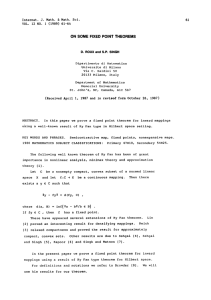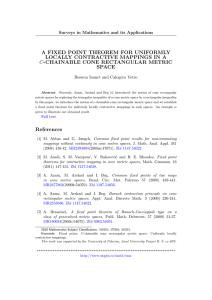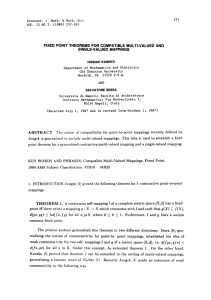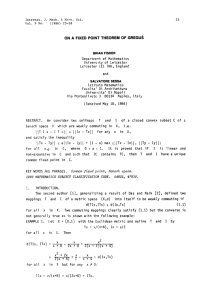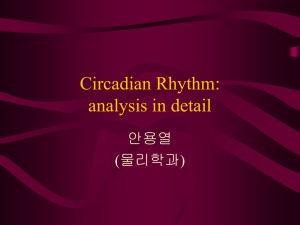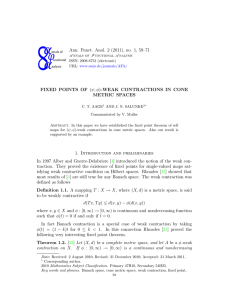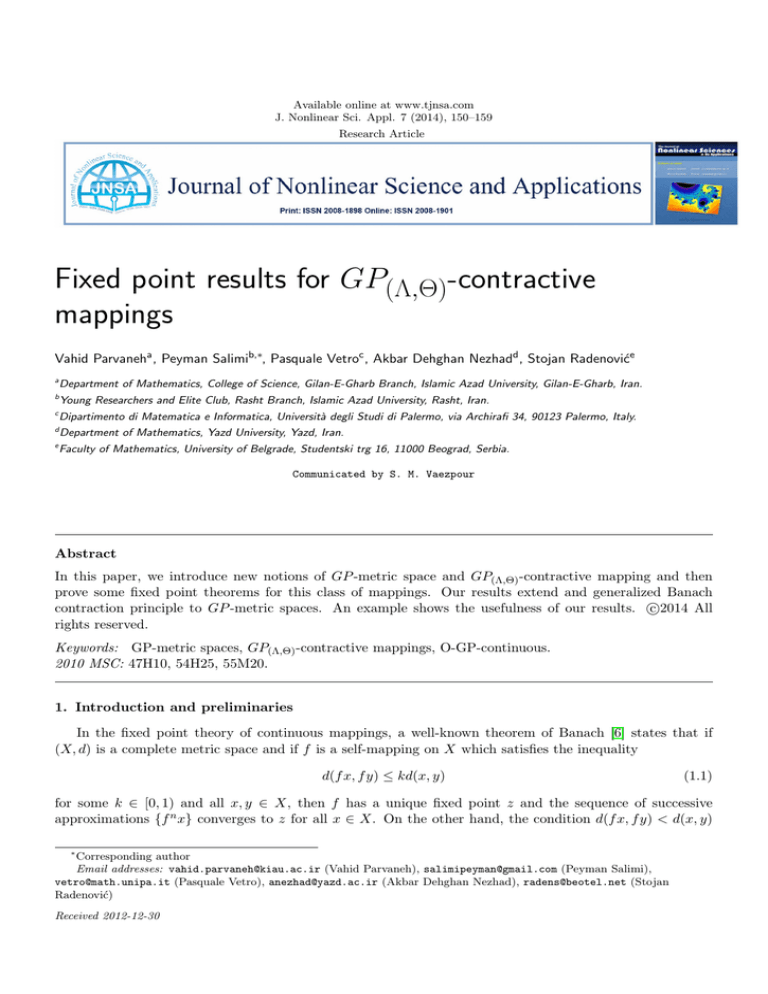
Available online at www.tjnsa.com
J. Nonlinear Sci. Appl. 7 (2014), 150–159
Research Article
Fixed point results for GP(Λ,Θ)-contractive
mappings
Vahid Parvaneha , Peyman Salimib,∗, Pasquale Vetroc , Akbar Dehghan Nezhadd , Stojan Radenoviće
a
Department of Mathematics, College of Science, Gilan-E-Gharb Branch, Islamic Azad University, Gilan-E-Gharb, Iran.
b
Young Researchers and Elite Club, Rasht Branch, Islamic Azad University, Rasht, Iran.
c
Dipartimento di Matematica e Informatica, Università degli Studi di Palermo, via Archirafi 34, 90123 Palermo, Italy.
d
Department of Mathematics, Yazd University, Yazd, Iran.
e
Faculty of Mathematics, University of Belgrade, Studentski trg 16, 11000 Beograd, Serbia.
Communicated by S. M. Vaezpour
Abstract
In this paper, we introduce new notions of GP -metric space and GP(Λ,Θ) -contractive mapping and then
prove some fixed point theorems for this class of mappings. Our results extend and generalized Banach
c
contraction principle to GP -metric spaces. An example shows the usefulness of our results. 2014
All
rights reserved.
Keywords: GP-metric spaces, GP(Λ,Θ) -contractive mappings, O-GP-continuous.
2010 MSC: 47H10, 54H25, 55M20.
1. Introduction and preliminaries
In the fixed point theory of continuous mappings, a well-known theorem of Banach [6] states that if
(X, d) is a complete metric space and if f is a self-mapping on X which satisfies the inequality
d(f x, f y) ≤ kd(x, y)
(1.1)
for some k ∈ [0, 1) and all x, y ∈ X, then f has a unique fixed point z and the sequence of successive
approximations {f n x} converges to z for all x ∈ X. On the other hand, the condition d(f x, f y) < d(x, y)
∗
Corresponding author
Email addresses: vahid.parvaneh@kiau.ac.ir (Vahid Parvaneh), salimipeyman@gmail.com (Peyman Salimi),
vetro@math.unipa.it (Pasquale Vetro), anezhad@yazd.ac.ir (Akbar Dehghan Nezhad), radens@beotel.net (Stojan
Radenović)
Received 2012-12-30
V. Parvaneh, et. al., J. Nonlinear Sci. Appl. 7 (2014), 150–159
151
does not ensures that f has a fixed point. In the last decades, the Banach’s theorem [6] has been extensively
studied and generalized on many settings, see for example [7, 9, 10, 13, 14, 15, 16, 17, 20, 25, 27, 32, 34, 35].
Partial metric space is a generalized metric space introduced by Matthews [19] in which each object does
not necessarily have to have a zero distance from itself. A motivation is to introduce this space to give a
modified version of the Banach contraction principle. Subsequently, several authors studied the problem
of existence and uniqueness of a fixed point for mappings satisfying different contractive conditions, for
example see [2, 5, 8, 11, 18, 28, 29, 30, 33].
On the other hand, in 2006 Mustafa and Sims [21] introduced a new notion of generalized metric spaces
called G-metric spaces. Based on the notion of a G-metric space, many fixed point results for different
contractive conditions have been presented, for more details see [1, 4, 22, 23, 24, 26, 31]. Recently, based
on the two above notions, Zand and Nezhad [36] introduced a new generalized metric space as both a
generalization of a partial metric space and a G-metric space. Following this direction of research, Aydi
et al. [3] established some fixed point results in GP -metric spaces which were first fixed point results in
GP -metric spaces.
In the present work, we introduce new notions of GP -metric space and GP(Λ,Θ) -contractive mappings and
study some fixed point results for GP(Λ,Θ) -contractive mappings in GP -metric spaces. Some fundamental
properties of the proposed metric are studied.
A (totally) ordered (abelian) group G is an additive group on which is defined an order relation < such
that if a < b, then a + c < b + c, for all a, b, c ∈ G. We write ≤ for < or =, and denote by G+ the set
of nonnegative elements of G. In the sequel, the letters R, R+ , Z+ and N will denote the set of all real
numbers, the set of all nonnegative real numbers, the set of all nonnegative integer numbers and the set of
all positive integer numbers, respectively.
Definition 1.1 ([12]). Let G be an ordered group. An ordered group metric (or OG-metric) on a nonempty
set X is a symmetric nonnegative function dG from X × X into G such that dG (x, y) = 0 if and only if
x = y and such that the triangle inequality is satisfied; the pair (X, dG ) is an ordered group metric space
(or OG-metric space).
Definition 1.2 ([36]). Let X be a non empty set and G be an ordered group. A function Gp : X ×X ×X −→
G+ is called an ordered group partial metric (or OGP -metric) if the following conditions are satisfied:
(GP1) x = y = z if Gp (x, y, z) = Gp (z, z, z) = Gp (y, y, y) = Gp (x, x, x);
(GP2) 0 ≤ Gp (x, x, x) ≤ Gp (x, x, y) ≤ Gp (x, y, z) for all x, y, z ∈ X;
(GP3) Gp (x, y, z) = Gp (x, z, y) = Gp (y, z, x) = · · · , symmetry in all three variables;
(GP4) Gp (x, y, z) ≤ Gp (x, a, a) + Gp (a, y, z) − Gp (a, a, a) for any x, y, z, a ∈ X.
Then the triple (X, G, Gp ) is called an OGP -metric space.
For example we can place G+ = Z+ or R+ . In the case G+ = R+ , the triple (X, R, Gp ) will often be
denoted by (X, Gp ) and is called a GP -metric space. In the sequel, for simplicity we assume that G+ = R+ .
Example 1.3 ([36]). Let X = R+ = G+ and define Gp (x, y, z) = max{x, y, z}, for all x, y, z ∈ X. Then
(X, Gp ) is a GP -metric space.
Proposition 1.4 ([36]). Let (X, Gp ) be a GP -metric space, then for any x, y, z and a ∈ X it follows that
(i) Gp (x, y, z) ≤ Gp (x, x, y) + Gp (x, x, z) − Gp (x, x, x);
(ii) Gp (x, y, y) ≤ 2Gp (x, x, y) − Gp (x, x, x);
(iii) Gp (x, y, z) ≤ Gp (x, a, a) + Gp (y, a, a) + Gp (z, a, a) − 2Gp (a, a, a);
V. Parvaneh, et. al., J. Nonlinear Sci. Appl. 7 (2014), 150–159
152
(iv) Gp (x, y, z) ≤ Gp (x, a, z) + Gp (a, y, z) − Gp (a, a, a).
Proposition 1.5 ([36]). Every GP -metric space (X, Gp ) defines a metric space (X, DGp ) where
DGp (x, y) = Gp (x, y, y) + Gp (y, x, x) − Gp (x, x, x) − Gp (y, y, y)
for all
x, y ∈ X.
Example 1.6. Let X = R+ = G+ and define Gp (x, y, z) = max{x, y, z}, for all x, y, z ∈ X. Then (X, Gp )
is a GP -metric space and DGP (x, y) = |x − y| for all x, y ∈ X.
Definition 1.7 ([36]). Let (X, Gp ) be a GP -metric space and let {xn } a sequence of points of X. A point
x ∈ X is said to be the limit of the sequence {xn } or xn → x if
lim
m,n→+∞
Gp (x, xm , xn ) = Gp (x, x, x).
If Gp (x, x, x) = 0 we say that the sequence {xn } is 0-GP -convergent to x.
Proposition 1.8 ([36]). Let (X, Gp ) be a GP -metric space. Then, for any sequence {xn } in X and a point
x ∈ X the following are equivalent:
(A) {xn } is GP -convergent to x;
(B) Gp (xn , xn , x) → Gp (x, x, x) as n → +∞;
(C) Gp (xn , x, x) → Gp (x, x, x) as n → +∞.
From the definition of DGP , we deduce the following proposition.
Proposition 1.9. Let (X, Gp ) be a GP -metric space. Then, for any sequence {xn } in X convergent to a
point x ∈ X such that lim Gp (xn , xn , xn ) = Gp (x, x, x), then DGP (xn , x) → 0.
n→+∞
Definition 1.10 ([36]). Let (X, Gp ) be a GP -metric space.
(S1) A sequence {xn } is called a GP -Cauchy sequence if and only if
lim
m,n→+∞
Gp (xn , xm , xm ) exists (and is
finite).
(S2) A GP -metric space (X, Gp ) is said to be GP -complete if and only if every GP -Cauchy sequence in X
is GP -convergent to some x ∈ X such that Gp (x, x, x) = lim Gp (xn , xm , xm ).
m,n→+∞
Lemma 1.11 ([3]). Let (X, Gp ) be a GP -metric space. Then
(A) if Gp (x, y, z) = 0, then x = y = z;
(B) if x 6= y, then Gp (x, y, y) > 0.
Lemma 1.12 ([3]). Let (X, Gp ) be a GP -metric space, x, y ∈ X and {xn } be a sequence in X. Assume
that limn→+∞ Gp (x, xn , xn ) = limn→+∞ Gp (xn , y, y) = 0, then x = y.
Lemma 1.13. Let (X, G) be a GP -metric space and {yn } ⊂ X be a sequence such that
Gp (yn , yn+1 , yn+1 ) ≤ λGp (yn−1 , yn , yn )
for some λ ∈ [0, 1) and each n ∈ N.
limm,n→+∞ Gp (xn , xm , xm ) = 0.
(1.2)
Then {yn } is a GP -Cauchy sequence in X such that
V. Parvaneh, et. al., J. Nonlinear Sci. Appl. 7 (2014), 150–159
153
Proof. For any m > n, by (GP4) and (1.2), we get
Gp (xn , xm , xm ) ≤ Gp (xn , xn+1 , xn+1 ) + Gp (xn+1 , xm , xm )
≤ Gp (xn , xn+1 , xn+1 ) + Gp (xn+1 , xn+2 , xn+2 ) + Gp (xn+2 , xm , xm )
≤ Gp (xn , xn+1 , xn+1 ) + · · · + Gp (xm−1 , xm , xm )
λn
≤
Gp (x0 , f x0 , f x0 ).
1−λ
This implies that limm,n→+∞ Gp (xn , xm , xm ) = 0, that is, {xn } is a GP -Cauchy sequence.
Definition 1.14. Let (X, Gp ) be a GP -metric space. A mapping f : X → X is 0-GP -continuous when
lim Gp (xn , xn , x) = 0
n→+∞
implies
lim Gp (f xn , f xn , f x) = 0.
n→+∞
2. Main Results
At first, we define the following notions.
Definition 2.1. Let f : X → X and Θ, Λ : X × X × X → R+ be two functions and λ > 0, θ ≥ 0 such that
θ
0 ≤ < 1. We say that f is (Λ, Θ)-admissible if
λ
x, y, z ∈ X
and
Λ(x, y, z) ≥ λ
imply
Λ(f x, f y, f z) ≥ λ
x, y, z ∈ X
and
Θ(x, y, z) ≤ θ
imply
Θ(f x, f y, f z) ≤ θ.
and
Definition 2.2. Let (X, Gp ) be a GP -metric space and f : X → X be a (Λ, Θ)-admissible mapping. f is a
hybrid GP(Λ,Θ) -contractive mapping if
1
Θ(x, y, z)Gp (x, f x, f x) ≤ Λ(x, y, z)Gp (x, y, z)
3
implies
Λ(x, y, z)Gp (f x, f y, f z) ≤ Θ(x, y, z)Gp (x, y, z) + LM (x, y, z)
(2.1)
for all x, y, z ∈ X where L ≥ 0 and
M (x, y, z) = min{max{DGp (f x, y), DGp (f x, z)}, max{DGp (f y, y), DGp (f z, z)}}.
From the definition of a hybrid GP(Λ,Θ) -contractive mapping, we deduce the following lemma.
Lemma 2.3. Let (X, Gp ) be a GP -metric space and f : X → X a hybrid GP(Λ,Θ) -contractive mapping.
The following hold:
(i) if z ∈ X is a fixed point of the mapping f , then Gp (z, z, z) = 0;
(ii) if z, w ∈ X are fixed points of the mapping f such that Θ(z, w, w) ≤ θ < λ ≤ Λ(z, w, w), then z = w.
Theorem 2.4. Let (X, Gp ) be a GP -metric space such that (X, Gp ) is GP -complete and f is a 0-GP continuous hybrid GP(Λ,Θ) -contractive mapping. If there exists x0 ∈ X such that Λ(x0 , f x0 , f x0 ) ≥ λ and
Θ(x0 , f x0 , f x0 ) ≤ θ. Then f has a fixed point in X.
V. Parvaneh, et. al., J. Nonlinear Sci. Appl. 7 (2014), 150–159
154
Proof. Let x0 ∈ X such that Λ(x0 , f x0 , f x0 ) ≥ λ and Θ(x0 , f x0 , f x0 ) ≤ θ. Define a sequence {xn } in X by
xn = f xn−1 for all n ∈ N. Since f is a (Λ, Θ)-admissible mapping and Λ(x0 , x1 , x1 ) = Λ(x0 , f x0 , f x0 ) ≥ λ, we
deduce that Λ(x1 , x2 , x2 ) = Λ(f x0 , f x1 , f x1 ) ≥ λ. By continuing this process, we get Λ(xn , xn+1 , xn+1 ) ≥ λ
for all n ∈ N ∪ {0}. Similarly, Θ(xn , xn+1 , xn+1 ) ≤ θ for all n ∈ N ∪ {0}. Also, if xn−1 = xn then xn is a
fixed point for f and we have nothing to prove and so we assume that xn−1 6= xn for all n ∈ N. That is
Gp (xn , xn+1 , xn+1 ) > 0 for all n ∈ N ∪ {0} and hence
1
θλ
Θ(xn−1 , xn , xn )Gp (xn−1 , xn , xn ) ≤
Gp (xn−1 , xn , xn )
3
3λ
≤ Λ(xn−1 , xn , xn )Gp (xn−1 , xn , xn ).
Now, using (2.1) with x = xn−1 and y = z = xn , we get
λGp (xn , xn+1 , xn+1 ) ≤ Λ(xn−1 , xn , xn )Gp (xn , xn+1 , xn+1 )
≤ Θ(xn−1 , xn , xn )Gp (xn−1 , xn , xn ) + L M (xn−1 , xn , xn )
≤ θGp (xn−1 , xn , xn )
and hence
Gp (xn , xn+1 , xn+1 ) ≤
θ
Gp (xn−1 , xn , xn ),
λ
for all n ∈ N.
(2.2)
θ
< 1, by Lemma 1.13, we deduce that {xn } is a GP -Cauchy sequence such that
λ
limm,n→+∞ Gp (xn , xm , xm ) = 0. Since X is GP -complete, then {xn } GP -converges to z ∈ X such that
Gp (z, z, z) = lim Gp (xn , xm , xm ) = 0. That is, the sequence {xn } is 0-GP -convergent to z. Now, using
Since, 0 ≤
m,n→+∞
the 0-GP -continuity of the mapping f and Proposition 1.4 (ii), we get
lim Gp (f z, f z, xn+1 ) ≤
n→+∞
≤
lim 2Gp (f z, xn+1 , xn+1 ) − lim Gp (xn+1 , xn+1 , xn+1 )
n→+∞
n→+∞
lim 2Gp (f z, f xn , f xn ) = 0.
n→+∞
Consequently,
lim Gp (xn , f z, f z) = 0.
n→+∞
As
lim Gp (xn , xn , z) = 0,
n→+∞
by Lemma 1.12, this yields z = f z.
For hybrid GP(Λ,Θ) -contractive mappings that are not 0-GP -continuous we have the following result.
Theorem 2.5. Let (X, Gp ) be a GP -metric space such that (X, Gp ) is GP -complete and f is a hybrid
GP(Λ,Θ) -contractive mapping. Assume that the following conditions hold:
(i) there exists x0 ∈ X such that Λ(x0 , f x0 , f x0 ) ≥ λ and Θ(x0 , f x0 , f x0 ) ≤ θ;
(ii) if {xn } is a sequence in X such that Λ(xn , xn+1 , xn+1 ) ≥ λ and Θ(xn , xn+1 , xn+1 ) ≤ θ for all n ∈ N
and xn → z ∈ X, then Λ(xn , z, z) ≥ λ and Θ(xn , z, z) ≤ θ for all n ∈ N ∪ {0}.
Then f has a fixed point.
Proof. Let x0 ∈ X such that Λ(x0 , f x0 , f x0 ) ≥ λ and Θ(x0 , f x0 , f x0 ) ≤ θ. Define a sequence {xn } in X
by xn = f n x0 = f xn−1 for all n ∈ N. Following the proof of the Theorem 2.4, we can say that {xn } is a
GP -Cauchy sequence such that Λ(xn , xn+1 , xn+1 ) ≥ λ and Θ(xn , xn+1 , xn+1 ) ≤ θ for all n ∈ N ∪ {0}. Since
X is GP -complete, then there is z ∈ X such that the sequence {xn } 0-GP -converges to z. Then by (ii), we
get Λ(xn , z, z) ≥ λ and Θ(xn , z, z) ≤ θ for all n ∈ N ∪ {0}.
V. Parvaneh, et. al., J. Nonlinear Sci. Appl. 7 (2014), 150–159
155
Now, we suppose that there exists n0 ∈ N such the following inequalities hold:
1
Θ(x2n0 , z, z)G(x2n0 , x2n0 +1 , x2n0 +1 ) > Λ(x2n0 , z, z)G(x2n0 , z, z)
3
and
1
Θ(x2n0 +1 , z, z)G(x2n0 +1 , x2n0 +2 , x2n0 +2 ) > Λ(x2n0 +1 , z, z)G(x2n0 +1 , z, z).
3
These relations imply
1
G(x2n0 , x2n0 +1 , x2n0 +1 ) > G(x2n0 , z, z)
3
and
1
G(x2n0 +1 , x2n0 +2 , x2n0 +2 ) > G(x2n0 +1 , z, z).
3
Then, by Proposition 1.4 (iii) and (2.2), we have
G(x2n0 , x2n0 +1 , x2n0 +1 ) ≤ G(x2n0 , z, z) + 2G(x2n0 +1 , z, z)
1
2
<
G(x2n0 , x2n0 +1 , x2n0 +1 ) + G(x2n0 +1 , x2n0 +2 , x2n0 +2 )
3
3
1
2
<
G(x2n0 , x2n0 +1 , x2n0 +1 ) + G(x2n0 , x2n0 +1 , x2n0 +1 )
3
3
= G(x2n0 , x2n0 +1 , x2n0 +1 )
which is a contradiction. Thus, for all n ∈ N, either
1
Θ(x2n0 , z, z)G(x2n0 , x2n0 +1 , x2n0 +1 ) ≤ Λ(x2n0 , z, z)G(x2n0 , z, z)
3
or
1
Θ(x2n0 +1 , z, z)G(x2n0 +1 , x2n0 +2 , x2n0 +2 ) ≤ Λ(x2n0 +1 , z, z)G(x2n0 +1 , z, z).
3
holds for every n ∈ N. Assume that the first of the previous inequalities holds for all n ∈ J ⊂ N. If J is an
infinite set, then using the contractive condition (2.1) and condition (ii), we deduce that
Gp (z, f z, f z) ≤ Gp (z, x2n+1 , x2n+1 ) + Gp (x2n+1 , f z, f z)
1
≤ Gp (z, x2n+1 , x2n+1 ) + Λ(x2n , z, z)Gp (f x2n , f z, f z)
λ
1
L
≤ Gp (z, x2n+1 , x2n+1 ) + Θ(x2n , z, z) Gp (x2n , z, z) + M (x2n , z, z)
λ
λ
θ
L
≤ Gp (z, xn+1 , xn+1 ) + Gp (xn , z, z) + M (x2n , z, z)
λ
λ
holds for all n ∈ J.
Since the sequence {xn } 0-GP -converges to z, we deduce
M (x2n , z, z) = min{DGP (x2n+1 , z), DGP (f z, z)} → 0
as
n → +∞.
Letting n → +∞ with n ∈ J, in the previous inequality, we obtain that Gp (z, f z, f z) ≤ 0, that is, z = f z.
Hence, f has a fixed point. If J is a finite set, we obtain the same result by considering the second
inequality.
Example 2.6. Define a GP -metric Gp on X = R+ by Gp (x, y, z) = max{x, y, z}. Let f : X → X be defined
by
1 2
if x ∈ [0, 1]
2x
f (x) =
3 ln x + 12 If x ∈ R+ \ [0, 1]
V. Parvaneh, et. al., J. Nonlinear Sci. Appl. 7 (2014), 150–159
and Λ, Θ : X × X × X → R+ be defined by
2
3 if x, y, z ∈ [0, 1]
Λ(x, y, z) =
0 otherwise.
and
156
1
Θ(x, y, z) = .
3
Now, we prove that all the hypotheses of Theorem 2.5 are satisfied and hence f has a fixed point; but
Banach contraction principle, with respect to the metric DGP , cannot be applied to f .
Proof. Let x, y, z ∈ X, if Λ(x, y, z) ≥ 23 then x, y, z ∈ [0, 1]. On the other hand, for all w ∈ [0, 1], we have
f w ≤ 1. Hence Λ(f x, f y, f z) ≥ 32 . Similarly, if Θ(x, y, z) ≤ 1/3, then Θ(f x, f y, f z) ≤ 1/3. This implies
that f is (Λ, Θ)-admissible. Clearly, Λ(0, f 0, f 0) ≥ 2/3 and Θ(0, f 0, f 0) ≤ 1/3.
Now, if {xn } is a sequence in X such that Λ(xn , xn+1 , xn+1 ) ≥ 2/3 and Θ(xn , xn+1 , xn+1 ) ≤ 1/3 for
all n ∈ N ∪ {0} and xn → z as n → +∞. Then {xn } ⊆ [0, 1] and hence z ∈ [0, 1]. This implies that
Λ(xn , z, z) ≥ 2/3 and Θ(xn , z, z) ≤ 1/3 for all n ∈ N ∪ {0}.
Let x, y, z ∈ [0, 1], then
2
max{f x, f y, f z}
3
1
1
max{x2 , y 2 , z 2 } ≤ max{x, y, z} = Θ(x, y, z)Gp (x, y, z).
=
3
3
Otherwise, Λ(x, y, z) = 0 and so
Λ(x, y, z)Gp (f x, f y, f z) =
0 = Λ(x, y, z)Gp (f x, f y, f z) ≤ Θ(x, y, z)Gp (x, y, z).
Then, f is a hybrid GP(Λ,Θ) -contractive mapping that satisfies all the conditions of Theorem 2.5 and
hence f has a fixed point.
Now, let d = DGP . By Example 1.6, we have d(x, y) = |x − y| for all x, y ∈ X. For x = e and y = 0, we
deduce
7
d(f e, f 0) = > k e = k d(e, 0)
2
for all k ∈ [0, 1) and so Banach contraction Principle cannot be applied to f .
Adding to Theorem 2.5 some hypotheses we can obtain the uniqueness of the fixed point.
Theorem 2.7. Let all the conditions of Theorem 2.4 (or Theorem 2.5) be satisfied. If the following condition
holds:
(j) for all z, w ∈ X such that z = f z and w = f w, we have Λ(z, w, w) ≥ λ and Θ(z, w, w) ≤ θ,
then f has a unique fixed point.
Proof. Follows by Theorem 2.4 (or Theorem 2.5) and Lemma 2.3.
If in Theorem 2.4 and Theorem 2.5 we take Λ(x, y, z) = 1, Θ(x, y, z) = θ where θ ∈ [0, 1) and L = 0,
then we deduce the Banach contraction principle in the setting of GP -metric spaces.
Corollary 2.8. Let (X, Gp ) be a GP -complete GP -metric space and f be a self-mapping on X. Assume
that there exists θ ∈ [0, 1), such that
Gp (f x, f y, f z) ≤ θGp (x, y, z)
for all x, y, z ∈ X. Then f has a unique fixed point.
V. Parvaneh, et. al., J. Nonlinear Sci. Appl. 7 (2014), 150–159
157
3. Fixed point in ordered GP -metric spaces
Let X be a nonempty set. If (X, Gp ) is a GP -metric space and (X, ) is partially ordered, then (X, Gp , )
is called an ordered GP -metric space. The points x, y ∈ X are called comparable if x y or y x holds.
The mapping f : X → X is called non-decreasing if x y implies f x f y for all x, y ∈ X. In this section,
we will show that many fixed point results in ordered GP -metric spaces can be deduced easily from our
presented theorems.
Theorem 3.1. Let (X, Gp , ) be an ordered GP -metric space such that (X, Gp ) is GP -complete and f :
X → X be a 0-GP -continuous and non-decreasing mapping. Assume that the following assertions hold:
(i)
1
3 Gp (x, f x, f x)
≤ Gp (x, y, z) implies
Gp (f x, f y, f z) ≤ λGp (x, y, z) + L M (x, y, z)
for all x, y, z ∈ X with x y z or x y z, where λ ∈ [0, 1) and L ≥ 0;
(ii) there exists x0 ∈ X such that x0 f x0 .
Then f has a fixed point in X.
Proof. Define the mappings Λ : X × X × X → R+ and Θ : X × X × X → R+ by
1 if x y z or x y z
and
Θ(x, y, z) = λ.
Λ(x, y, z) =
0 otherwise
Clearly, the mapping f satisfies the contractive condition (2.1). Now, let x, y, z ∈ X such that Λ(x, y, z) ≥ 1.
By the definition of the function Λ, this implies that x y z or x y z. As the mapping f is nondecreasing, we deduce that f x f y f z or f x f y f z and hence Λ(f x, f y, f z) ≥ 1. Consequently,
f is a hybrid GP(Λ,Θ) -contractive mapping. The condition (ii) ensures that there exists x0 ∈ X such that
x0 f x0 . This implies that Λ(x0 , f x0 , f x0 ) ≥ 1. Therefore, all the hypotheses of Theorem 2.4 are satisfied
and hence f has a fixed point.
For self-mappings that are not 0-GP -continuous we have the following result.
Theorem 3.2. Let (X, Gp , ) be an ordered GP -metric space such that (X, Gp ) is GP -complete and f :
X → X be a non-decreasing mapping. Assume that the following assertions hold:
(i) there exists λ ∈ [0, 1) and L ≥ 0 such that 31 Gp (x, f x, f x) ≤ Gp (x, y, z) implies
Gp (f x, f y, f z) ≤ λGp (x, y, z) + L M (x, y, z)
for all x, y, z ∈ X with x y z or x y z;
(ii) there exists x0 ∈ X such that x0 f x0 ,
(iii) if {xn } is a non-decreasing sequence in X and xn → z ∈ X, then xn z for all n ∈ N ∪ {0}.
Then f has a fixed point in X.
Acknowledgements:
The third author is supported by Università degli Studi di Palermo, Local University Project R. S. ex
60%.
V. Parvaneh, et. al., J. Nonlinear Sci. Appl. 7 (2014), 150–159
158
References
[1] M. Abbas, T. Nazir and P. Vetro, Common fixed point results for three maps in G-metric spaces, Filomat, 25:4 (2011),
1–17. 1
[2] H. Aydi, M. Abbas and C. Vetro, Partial Hausdorff metric and Nadler’s fixed point theorem on partial metric spaces,
Topology Appl., 159 (2012), 3234–3242. 1
[3] H. Aydi, E. Karapinar, P. Salimi, Some fixed point results in GP -metric spaces, J. Appl. Math., 2012 (2012), Article ID
891713. 1, 1.11, 1.12
[4] H. Aydi, W. Shatanawi and C. Vetro, On generalized weak G-contraction mapping in G-metric spaces, Comput. Math.
Appl., 62 (2011), 4223–4229. 1
[5] H. Aydi, C. Vetro, W. Sintunavarat and P. Kumam, Coincidence and fixed points for contractions and cyclical contractions
in partial metric spaces, Fixed Point Theory Appl., 2012: 124 (2012). 1
[6] S. Banach, Sur les opérations dans les ensembles abstraits et leur application aux équations intégrales, Fund. Math., 3
(1922), 133–181. 1, 1
[7] V. Berinde and F. Vetro, Common fixed points of mappings satisfying implicit contractive conditions, Fixed Point Theory
Appl., 2012:105 (2012). 1
[8] S.K. Chatterjea, Fixed point theorem, Comte Rend. Acad. Bulgare Sc., 25 (1972), 727–730. 1
[9] S. Chauhan and B.D. Pant, Fixed point theorems for compatible and subsequentially continuous mappings in Menger spaces,
J. Nonlinear Sci. Appl. 7 (2) (2014), 78–89. 1
[10] Lj.B. Ćirić, A Generalization of Banach’s contraction principle, Proc. Amer. Math. Soc., 45 (1974), 267–273. 1
[11] Lj.B. Ćirić, B. Samet, H. Aydi and C. Vetro, Common fixed points of generalized contractions on partial metric spaces
and an application, Appl. Math. Comput. 218 (2011), 2398–2406. 1
[12] L. W. Cohen and C. Goffman, The topology of ordered Abelian groups, Trans. Amer. Math. Soc., 67 (1949), 310–319. 1.1
[13] B. Damjanovic, B. Samet and C. Vetro, Common fixed point theorems for multi-valued maps, Acta Math. Sci. Ser. B Engl.
Ed. 32 (2012), 818–824. 1
[14] C. Di Bari and P. Vetro, Fixed points for weak φ-contractions on partial metric spaces, Int. J. of Engineering, Contemporary
Mathematics and Sciences, 1 (2011), 5–13. 1
[15] C. Di Bari, M. Milojević, S, Radenović and P. Vetro, Common fixed points for self-mappings on partial metric spaces,
Fixed Point Theory Appl., 2012:140 (2012). 1
[16] C. Di Bari, Z. Kadelburg, H. Nashine and S. Radenović, Common fixed points of g-quasicontractions and related mappings
in 0-complete partial metric spaces, Fixed Point Theory Appl., 2012:113 (2012). 1
[17] R. Kannan, Some results on fixed points, Bull. Cal. Math. Soc., 60 (1968), 71–76. 1
[18] V. La Rosa and P. Vetro, Fixed points for Geraghty-contractions in partial metric spaces, J. Nonlinear Sci. Appl. 7 (1)
(2014), 1–10. 1
[19] S.G. Matthews, Partial metric topology, in: Proc. 8th Summer Conference on General Topology and Applications, Ann.
New York Acad. Sci., 728 (1994), 183–197. 1
[20] D. Miheţ, Common coupled fixed point theorems for contractive mappings in fuzzy metric spaces, J. Nonlinear Sci. Appl. 6
(1) (2013), 35–40. 1
[21] Z. Mustafa and B. Sims, A new approach to generalized metric spaces, J. Nonlinear Convex Anal., 7 (2) (2006), 289–297. 1
[22] Z. Mustafa and H. Obiedat, A fixed point theorem of Reich in G-metric spaces, CUBO, 12 (1) (2010), 83–93. 1
[23] Z. Mustafa, W. Shatanawi and M. Bataineh, Existence of fixed point results in G-metric spaces, Int. J. Math. Math. Sci.,
2009 (2009) Article ID 283028, 10 pages. 1
[24] Z. Mustafa and B. Sims, Fixed point theorems for contractive mappings in complete G-metric spaces, Fixed Point Theory
Appl., 2009 (2009), Article ID 917175, 10 pages. 1
[25] D. Paesano and P. Vetro, Suzuki’s type characterizations of completeness for partial metric spaces and fixed points for
partially ordered metric spaces, Topology Appl., 159 (2012), 911–920. 1
[26] S. Radenović, P. Salimi, S. Pantelic and J. Vujaković, A note on some tripled coincidence point results in G-metric spaces,
2012, Int. J. Math. Sci and Engg. Appls., 6 No. VI (November 2012), 23–38. 1
[27] S. Reich, Kannan’s fixed point theorem, Boll. Un. Mat. Ital. 4 (1971), 1–11. 1
[28] I.A. Rus, Fixed point theory in partial metric spaces, Anal. Univ. de Vest, Timisoara, Seria Matematică-Informatică, 46
(2008), 141–160. 1
[29] B. Samet, M. Rajović, R. Lazović and R. Stoiljković, Common fixed point results for nonlinear contractions in ordered
partial metric spaces, Fixed Point Theory Appl., 2011:71 (2011). 1
[30] B. Samet, C. Vetro and P. Vetro, Fixed point theorems for α-ψ-contractive type mappings, Nonlinear Anal., 75 (2012),
2154–2165. 1
[31] R. Saadati, S.M. Vaezpour, P. Vetro and B.E. Rhoades Fixed point theorems in generalized partially ordered G-metric
spaces. Mathematical and Computer Modelling., 52 (2010), 797–801. 1
[32] T. Suzuki, A generalized Banach contraction principle that characterizes metric completeness, Proc. Amer. Math. Soc.,
136 (2008), 1861–1869. 1
[33] C. Vetro and F. Vetro, Common fixed points of mappings satisfying implicit relations in partial metric spaces, J. Nonlinear
Sci. Appl. 6 (3) (2013), 152–161. 1
[34] F. Vetro, On approximating curves associated with nonexpansive mappings, Carpathian J. Math., 27 (2011), 142–147. 1
V. Parvaneh, et. al., J. Nonlinear Sci. Appl. 7 (2014), 150–159
159
[35] F. Vetro and S. Radenović, Nonlinear ψ-quasi-contractions of Ćirić-type in partial metric spaces, Appl. Math. Comput.,
219 (4) (2012), 1594–1600. 1
[36] M.R.A. Zand and A.D. Nezhad, A generalization of partial metric spaces, Journal of Contemporary Applied Mathematics.
24 (2011), 86–93. 1, 1.2, 1.3, 1.4, 1.5, 1.7, 1.8, 1.10

